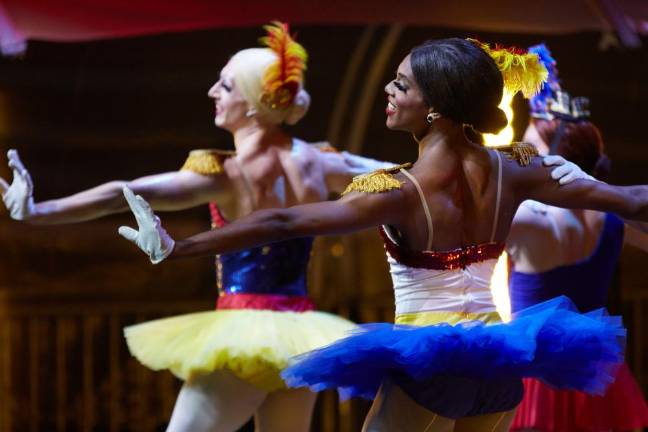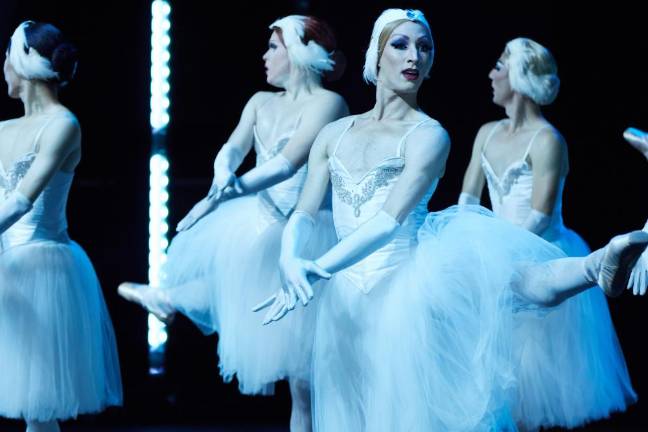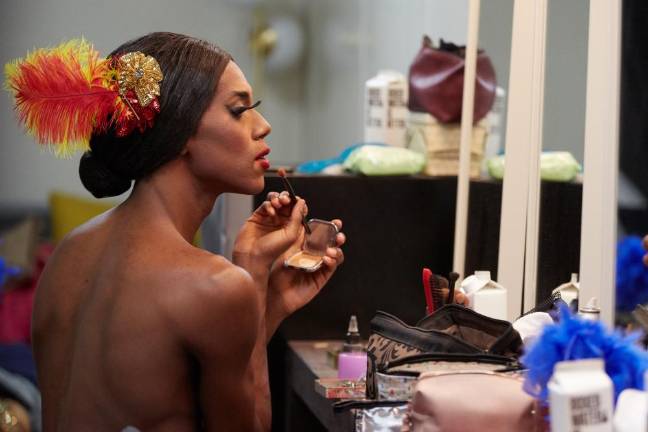Of all the documentaries Chana Gazit has made in her decorated career, she named “Ballerina Boys” as the one that has brought her the most joy. The documentary takes viewers behind the scenes of Les Ballets Trockadero de Monte Carlo, the troupe of all-male ballerinas who dance on pointe and in drag.
Founded in 1974 after the Stonewall riots, the company, known as “The Trocks,” performs classical ballets imbued with parody. In their 45-year history, they have pushed the envelope not only by having men wearing tutus on stage, but by their courageous acts — such as casting a black man in the role of the Swan Queen and going on tour in states known to harbor anti-gay sentiments.
Gazit, whose three Emmy Awards for her work on “The Pill,” “Slavery and the Making of America” and “Honorable Nations,” sit on a shelf in her Upper West Side apartment, founded Merrywidow Films with her friend Martie Barylick in 2017. Their first labor of love was “Ballerina Boys,” which took rounds of fundraising and six years to complete. Once it was previewed by PBS, the station gave them the finances to complete the project for its “American Masters” series.
How did the idea for the film come about?
Martie and I had been really good friends. Martie is a dancer, choreographer and dance entertainer. And we spent New Year’s Eve of 2014 into 2015 together and she had the brilliant idea of saying, “Let’s go see the Trocks.” And, of course, she was very familiar with them and they were completely new to me. So really that was the moment it started. And then the next couple of weeks, it kept on fermenting ... And we set about to fund-raise for it. So I was the film person; she was the dance person. And we thought together we could really do this.
If you could explain the Trocks in your own words, how would you describe the company?
A group of little boys who wanted to grow up to be ballerinas and did. They are all male ballet dancers who dance, for the most part, strictly the ballerina roles in costume, in tutus and on pointe. And the key thing — and Martie was really instrumental in making me realize this — is the extraordinary technical level that they dance at. She called them, “the NFL of ballet.” And one can hardly imagine a woman’s body going on pointe, so to think of a man’s body on pointe — and some of these dancers are 6’2’’ — it’s an extraordinary physical feat that they do. And on top of that, they really infuse the very classical Russian ballet and others with comedy. And that is really the key to their success, extraordinary dancing and just being fun and joyous to audiences.
Through your research, what is something you discovered about them that surprised you?
We went on tour with them in 2018 in North and South Carolina. And so we literally rode on the bus with them and were with them 24/7. That was a completely new experience — to go on the road with a tour company and watch them put on this incredibly sophisticated show every night was really stunning. It was also stunning how much they work. They have regular ballet class every morning, then they go and do staging and rehearsing in the afternoon. And then they go ahead and do the show at night. So the stamina that they need is mind boggling.
There’s a scene where the dancers are watching RuPaul and discussing drag. Explain what you learned about drag and how people misconstrue what it is.
I think the first thing that I really came to understand is that drag is a political statement. There’s a level of whether you call it resistance in that, but it’s not just dressing up in outlandish women’s clothing. It really is about making a statement about creativity, freedom, acceptance and tolerance, kind of to loosen the tight structures of gender. It’s hard, I think, to watch the film and not begin to think about issues of gender. We knew that was there in that film.
There’s also a part dedicated to the AIDS epidemic and how it affected the company. Tell us about that.
The most extraordinary thing about the company is that they’ve survived for 45 years, which is, for any small dance troupe, a sheer miracle. And so very much we looked at it as a story of survival. And in the AIDS epidemic, where they lose half of their dancers, it was amazing that they continued past that. And they not only continued past that, but I think it came with a new sense of commitment to what they were doing. And a new sense of the importance of, not only their message, but also the importance of joy in a dark world.
Explain the Trocks’ history in New York. I thought it was interesting that audiences would show up in limos after going to Lincoln Center.
The thing is, their first performances were in the Meatpacking District, when the Meatpacking District was the Meatpacking District. And they would perform in these rundown lofts and audiences would sit on dinky folding chairs. But all the sudden, word got out, and you had the likes of [Mikhail] Baryshnikov coming to see them. And it really became a thing to go and see them. I think that’s probably what gave them the confidence. They knew very early on that they did not want to limit themselves to the kind of avant-garde world of New York City. That they were determined to go and bring what they do to every corner of this country. So they go into small towns, what we consider red states, and they really, really wanted to bring their show everywhere. And much to their surprise, people loved them and wanted to see more of them.
The film ends with them performing at SummerStage for the 50th anniversary of Stonewall. Explain the significance of that scene and why you chose it as the last one.
It was so key, because the company was formed in the wake of the Stonewall riots in 1969. That event so much fueled both their spirit and their determination, and the sense of freedom that they felt. In 1969, in many states, a man could be arrested for wearing women’s clothes. So what they were doing was really quite revolutionary at the time. So that they were now going to perform for the 50th anniversary of the Stonewall riots at the iconic Central Park SummerStage felt like it was really closing the circle. And especially to dance to “Stars and Stripes Forever,” which was based on a 1959 [George] Balanchine ballet, and the ballet was super militaristic and patriotic and with [John Philip] Sousa music. And there’s just something so bold, profound and just joyous about seeing them in their drag ballet ballerina costumes redefining what patriotism means.
What do you hope viewers will take away from “Ballerina Boys?”
I hope that the viewers come to love them as we have come to love them. And I hope that they, for the hour of the film, think about gender in a much more fluid, and much less rigid way. That somehow they warm your heart to the point where it’s all okay.
“Ballerina Boys” will premiere on June 4 on PBS’ “American Masters.”
www.ballerinaboysfilm.com




